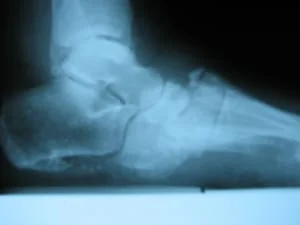NAVICULOCUNEIFORM JOINT ARTHRITIS
By: Robert H. Sheinberg, D.P.M., D.A.B.F.A.S., F.A.C.F.A.S.
CAUSES:
- Trauma to the midfoot region either direct or from twisting movements.
- Flatfoot deformity that has progressed over the years.
- When due to a flatfoot deformity usually associated with a tight calf muscle.
SIGNS AND SYMPTOMS:
- Mild to moderate lowering of the longitudinal arch with weight-bearing.
- Pain with weight-bearing and difficulty walking or running.
- Possible prominent bone on the top or inside of the arch indicative of advanced changes.
- Extreme tenderness to palpate the joint on both the top and bottom.
- Thickening of the ligament on the bottom of the joint.
X-RAYS:
- X-rays usually reveal narrowing of the joint surface. Bone spurring may develop on the top or inside of the joint. The joint appears to have collapsed in that region.
TREATMENT:
- For mild cases the use of a well-molded custom molded orthotic in a running sneaker may provide some benefit.
- May need Achilles tendon lengthening if severely contracted.
- Moderate to severe cases that are unresponsive to conservative care usually necessitate a fusion of the naviculocuneiform joint. These joints can be fused with no expected long-term adverse effects. Can usually return to all sports and have a complete recovery.
The image below is that of a navicular-cuneiform dislocation.

Old Lis Franc injury with post-traumatic arthritis treated with tarsometatarsal fusion (below)



